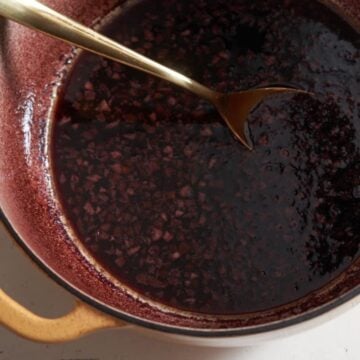Blooming spices is one of my top kitchen tips! What is it? Why should you do it? Let's find out all the reasons to master this simple cooking technique.

Blooming spices will make all of your recipes taste much better, and will yield a better texture. It's very easy—you may already be doing it!
This technique is commonly used in all kinds of cuisines from South Asian curries, to Eastern European dishes, to Mexican recipes like mole.
Jump to:
What is blooming spices?
To bloom spices means to cook them quickly in some kind of fat—butter, oil, ghee, rendered bacon fat, etc., to awaken them. This process can take place at the start of the recipe—think of it as creating the base of your flavors—or sometimes spices are sizzled in oil and added to a dish at the very end to punch up the taste.
How does it improve flavor and texture?
Spices are made of plants that are literally dried out. Adding fat back into the equation "wakes them up" by dissolving them into the fat. This helps you to taste the spices better because the fat allows the flavor to hang around on your tongue longer, you're literally tasting them more!
Want to save this recipe?
You'll join hundreds of readers on my email list!
From a textural standpoint, the spices will be softened and embedded with the other ingredients in the recipe. For example, when you're making chicken paprikash or chili, two recipes with a lot of dried spices, blooming them in fat eliminates any grittiness by softening them and distributing them evenly throughout the dish. (Because no one wants spices floating around on top of their chili!)
What about fresh herbs and other aromatics?
Yes, it's the same thing! When adding herbs like rosemary and thyme along with grated garlic to the base of Tuscan white bean soup or Thanksgiving stuffing, you're infusing that flavor into fat that will permeate the whole dish.
Be careful not to burn!
Don't overdo it! You generally only need anywhere from 30 seconds to two minutes to bloom spices, fresh herbs, and aromatics like garlic and ginger, just until they are softened and fragrant. When you smell that wonderful aroma, you've done it, so be ready to add your liquid like stock, tomato sauce, or wine to continue with the rest of the recipe.
What kinds of recipes use this technique?
- It's a must when making recipes with curry powder like this Chickpea Stew.
- You'll do this to wake up the oregano when you make Greek Stuffed Peppers.
- Sizzle the cumin seeds and paprika to flavor the sauce for Shakshuka with Feta.
- Rendered bacon fat is the vehicle for blooming the spices in Sweet Potato Corn Chowder.





Leave a Reply